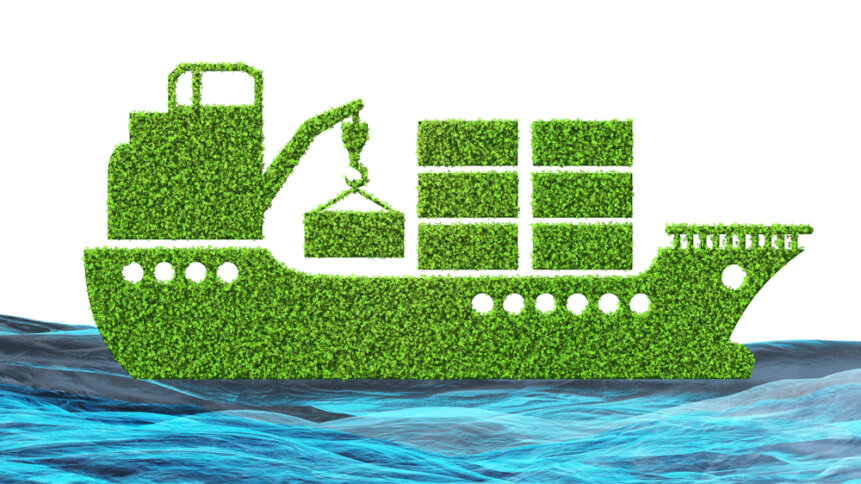Green shipping sails ahead of other transport sectors

To mitigate the high level of greenhouse gas emissions coming from the shipping and logistics industry, at COP27 in late 2022, the United States and Norway organized the Green Shipping Challenge. The Challenge urged ports, companies and governments to commit to the transition to greener shipping, and now, the first changes are being made to help the industry transition to a green shipping model.
In 2022, the US proposed a green shipping route between Seattle and Busan – a route to which South Korea agreed. It would be the third green corridor globally, after the Los Angeles-Shanghai and Singapore-Rotterdam routes.
The potential route has already got possible deployments, as Korean HNM has ordered newbuild methanol-fuelled containerships to the tune of $1.12 billion. Methanol is being used as an alternative fuel across the shipping industry, because of its relatively low-carbon profile, which qualifies it as a “green fuel.” Green fuels are those with a 65%-95% reduction in lifecycle CO2 emissions compared to fossil fuels.
President and CEO of HMM, Kim, Kyung Bae, said “we will continue to drive efforts to support the global community’s broader transition to carbon neutrality while at the same time strengthening our fundamental level of future capability in the face of increasingly fierce competition in the global market.”
The newbuild order is set to be operational by 2025 and 2026 – it will be split, with seven newbuilds at Hyundai Samho Heavy industries and two at HJ Shipbuilding and Construction. HNM are hot on the tracks of Maersk, which has just signed its ninth green methanol deal globally, with Sungas. The facility is due for 2026 and will use residues from forestry and wood production as feedstock, using sustainable sourcing methods.
The US Environmental Protection Agency says that the transportation sector as a whole contributes 14% of all global greenhouse gas emissions, which is why there are significant pushes towards electric vehicle take up on the roads of the developed world.
Shipping is known to contribute 2-3% of all greenhouse emissions on its own, and so alternative, relatively green fuels, and significantly more efficient routes, must be found and deployed as soon as they’re viable. But the sector cannot be suddenly halted while it gets green: shipping transports close to 80% of global trade by volume. Were it to halt for even a relatively short time, shelves in stores around the world would be empty, and both economies and governments would likely crash.
Elsewhere in the transport sector, airlines are trying to make planes greener too. But whereas for instance, on the roads, the push towards the electrification of haulage fleets and the deployment of sophisticated logistics technology to optimize routes for ecological friendliness have taken the front seat, and shipping is beginning to really make some strides in the use of green methanol as an alternative to fossil fuels, in the air, sustainable energy sources has taken a backseat to the significantly cheaper option of reducing greenhouse gases.
So far, airlines have changed in what could be thought of as relatively tokenistic ways – by installing carbon fiber seats, reducing the number of magazines on board any flight, the use of lighter drinks carts, and in-flight phones being scrapped.
Green shipping ahead of other transportation modes.
More optimistically, KLM has flown a passenger jet from the Netherlands to Paris using biofuel (though less cheerfully, it was gathered from meat production, which is a whole eco-nightmare of its own). Also, EADS, the owner of Airbus, has flown planes running on algae biofuels. The company is now working on a hypersonic jet that will be fuelled by biofuels made from seaweed.
Since 10 January 2022, KLM has been using 0.5% Sustainable Aviation Fuel (SAF) for all its flights from Amsterdam. There is an option for passengers to pay for their flight to use more SAF — after all, never mind the climate emergency, there’s got to be profit. The green revolution, like most revolutions before it, will be monetized!
Freight movement using trucks is also undergoing change. Sustainable trucking technologies are being introduced, such as active aerodynamics enabler, TruckWings. Without requiring any effort from drivers, the installation of these technologies can result in fuel savings of up to 4.1%, the equivalent of 20,000 pounds worth of CO2 per vehicle per year. Again, alternative fuel vehicles (AFVs) are an option, and (when combined with advanced logistics software) can eventually work out better not only for the planet but also for businesses’ bottom lines – but the expense of the initial outfitting of fleets with AFVs seems to be preventing mass adoption so far.
US Representative Rodney Davis introduced the STEER Act (Support Trucking Efficiency and Emission Reductions) in 2021, aiming to help fleet owners reduce emissions and move towards more sustainable practices by incentivizing emission-reducing technologies.
Meanwhile, the shipping sector has sailed ahead in terms of sustainability. Hopefully, the large investments in containerships that use methanol will set an example for the rest of the industry.











